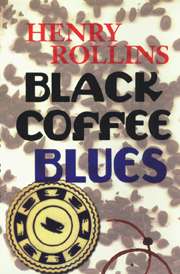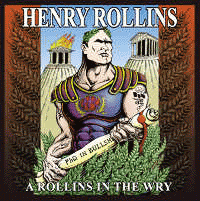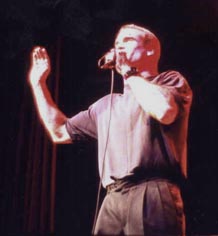|
Some critics hail Henry Rollins as a modern-day "renaissance man." His resumé seems to merit the label: prolific writer, actor, spoken word performer, founder of 2.13.61 Publications and, of course, front man for the Rollins Band and the seminal punk group Black Flag. Rollins’ caffeinated and tattooed body has somehow reached the age of forty—that milestone prompting so many (including Rollins) to reflect on maturity and how they got there. This seems an appropriate time to examine the relationships between his many disparate achievements and to pose this question: Henry Rollins—renaissance man or jack-of-all-trades? Serious artist in all formats or dabbler? In our brief interview, Rollins shed some light on these questions, as he discussed his influences, his goals and his philosophy. His recent spoken word performance at the Cal State campus in Chico, California provided another angle on this enigma.
Rollins’ most visible work is in music, film and television. His appearances in films such as David Lynch’s Lost Highway, on MTV and VH1 and (to the chagrin of punker-than-thou fans) on voice-overs for pickup truck commercials have earned him a certain niche in popular culture. While these demonstrate his eagerness to reinvent himself, his roots are firmly planted in punk rock ‘n’ roll. From his early days with Black Flag to his most recent Rollins Band album, Rollins’ raw energy, brutal lyrics and aggressive vocals have earned him a reputation as an intense and charismatic hard rock performer.
Always outspoken on the sins of the music industry, he criticizes the way it clogs the radio waves "with three record labels, five bands." At his spoken word show at Chico State, he discussed the ways in which the record labels’ "artist disposal" marketing system creates "temporary music for our new temporary culture" and, by extension, temporary people to buy it and listen to it. At the reading, he exhorted the young audience to dig through their parents’ record collections and get turned on to the likes of Bob Dylan and Duke Ellington.
Rollins’ relationship to the music scene seems somewhat contradictory—at times, he seems to think it has nothing to do with him. At other times, he feels the need to engage critically with the beast. He has often threatened to simply leave this arena. In contrast, Lou Reed claims he'll be a musician until the day he dies—in 1976, Lester Bangs quoted him as bragging that "quite likely he'd live forever" but he had "these eight hundred albums in the can just in case." Rollins, however, implies that he'll retire from music once he starts to get a little long in the tooth: "I'll retire when my music isn't hittin' like it should," he told me. "Not before. I can't care about what's happening around me in the music world. It doesn't concern me, and it doesn't have a thing to do with what I am doing." Yet he respects Reed’s persistence: "Lou will definitely play music until he dies. His last album was amazing."
 Nice, the Rollins Band’s most recent album (not counting A Nicer Shade of Red, a compilation of Nice outtakes), shows Rollins moving in new musical directions, with no retirement in sight. With a new band and a new sound (featuring soulful backup singers), he is exploring funky raps and rhythms (à la the Red Hot Chili Peppers) and jazzy flourishes, along with his accustomed rip ’n’ grind. The album’s glossy commercial sound is not exactly punk, but Rollins’ lyrics restate his musical thesis: I am a human tank. Go on, make my day. Nice, the Rollins Band’s most recent album (not counting A Nicer Shade of Red, a compilation of Nice outtakes), shows Rollins moving in new musical directions, with no retirement in sight. With a new band and a new sound (featuring soulful backup singers), he is exploring funky raps and rhythms (à la the Red Hot Chili Peppers) and jazzy flourishes, along with his accustomed rip ’n’ grind. The album’s glossy commercial sound is not exactly punk, but Rollins’ lyrics restate his musical thesis: I am a human tank. Go on, make my day.
Much of Rollins’ literary output reflects his lifetime on the road with rock bands and spoken word tours. For example, in Get In The Van (1994), Black Coffee Blues (1992) and Do I Come Here Often? (1996), he focuses on chronicling his travels, performances and other music-related experiences. These journals/memoirs clearly connect his musical and literary careers, but they represent only one aspect of his writing.
 The darker vein of Rollins’ writing, including much of his early work as well as Solipsist (1998), portrays a nightmarish urban world of isolation, visionary moments, brutal violence and primal sexuality. It would be too easy to call this area of his work "fiction," as his brand of storytelling doesn’t clearly distinguish between the autobiographical and the imaginative. Trying to extrapolate an image of Rollins from these writings would make us see him as a twisted, paranoid, emotionally disfigured narrator of obscenity and violence—an image that doesn’t jive with his unstoppable rock star image and, as we shall see later, his comedic, friendly, spoken word persona. The darker vein of Rollins’ writing, including much of his early work as well as Solipsist (1998), portrays a nightmarish urban world of isolation, visionary moments, brutal violence and primal sexuality. It would be too easy to call this area of his work "fiction," as his brand of storytelling doesn’t clearly distinguish between the autobiographical and the imaginative. Trying to extrapolate an image of Rollins from these writings would make us see him as a twisted, paranoid, emotionally disfigured narrator of obscenity and violence—an image that doesn’t jive with his unstoppable rock star image and, as we shall see later, his comedic, friendly, spoken word persona.
To understand Rollins’ more extreme writing within the context of his other work, it is helpful to know something of his publishing history. He founded 2.13.61 Publications almost as a joke in 1983, with the goal of printing 500 copies of a small fold-staple booklet of his writing. Since then, the company has expanded its roster of artists to include writings by Hubert Selby, Jr., Henry Miller, Iggy Pop, underground filmmaker Nick Zedd, lyrics by Nick Cave and Roky Erickson (of the 13th Floor Elevators) and, of course, some twelve books by Rollins, as well as compact disks and other products.
Obviously, running the publishing company has a practical appeal for Rollins: it allows him to hustle his wares "artist direct" to the public and, thus, eat. But it also has a mission of sorts: introducing confrontational, non-mainstream, thought-provoking voices into American literature. It also allows Rollins to pay tribute to his influences, especially Henry Miller and Hubert Selby, Jr.
I asked him if he saw his writing as an extension of a surrealist literary tradition, the tradition of Miller, Anais Nin, D.H. Lawrence, etc., and whether he attempts to portray a psychological or subconscious version of reality or simply life as he sees it. "I sometimes try and go for a hyper real situation, which often nails down an emotional reality. Not the real world, perhaps, but the one that drives one to kill the one they love in the heat of the moment. Writing is very good for this. Leautreamont and Kafka come to mind." Of Selby and Darren Aronofsky's film version of Requiem for a Dream, he said, "We [he and Selby] met in December of 1986. He was pretty much like he is to me now. Incredibly kind and generous with his time. He's a bright light. I thought the film was devastating. Really innovative. I don't know if I'll be seeing it again. A little of that went a long way. Ellen Burstyn was amazing." Tracing the influences of other writers in Rollins’ work clarifies some of the directions he takes in his literary output, but it doesn’t explain how his writing intersects with his other artistic pursuits.
 Reconciling
Rollins’ print-based literary output with his spoken
word performances proves a difficult task: instead of
the grim obsessive artist, he comes across as a natural-born
comic, a class clown—an entertainer. On A Rollins
in the Wry (2000), his material is light-hearted,
humorous, somewhat sophomoric; his delivery hammy, upbeat
and crowd-pleasing. It’s not an Adam Sandler CD,
but it’s not far off. Reconciling
Rollins’ print-based literary output with his spoken
word performances proves a difficult task: instead of
the grim obsessive artist, he comes across as a natural-born
comic, a class clown—an entertainer. On A Rollins
in the Wry (2000), his material is light-hearted,
humorous, somewhat sophomoric; his delivery hammy, upbeat
and crowd-pleasing. It’s not an Adam Sandler CD,
but it’s not far off.
At his performance at Chico
State, Rollins commanded the attention of about 900 college
students as he gabbed, goofed and sermonized for two-and-a-half
hours—without notes, without a pause, without a hitch.
German art films, Scandinavian languages, Kenny G. ("The
guy I had a chance to kill"), Home Depot, auditioning
for a DeVito film, Men v. Women, the U.S.’s impending
take-over of Canada: all fuel for the Rollins engine,
culled from his travels and life on the road. The crowd
roared at some of Rollins’ more quotable moments:
"Stick your hand up your ass—you’ll find
a Starbucks." "LA: It’s where my modem
is." Funniest by far were his Men v. Women dialogues
(women voiced in falsetto), his impression of an interview
with the lead singer of Iron Maiden and his sustained
monologue on trying to make the high school wrestling
team—delivered from the vantage point of being pinned
under his opponent’s ass.
 |
| Photo by Jon Demaree |
Amid these routines, he did drop some clues that tied back into his books; for example, he described his flight from Australia to Germany as a surreal experience: "By the time you reach Europe, you ARE surrealism; you are the father of surrealism; you are André Breton." At another point, he talked about finding an unusual copy of a Henry Miller book on his mom’s bookshelf: "She bought it from Henry Miller at a gallery opening—he hustled her for gas money." Still, it is difficult to see how the same man produces these two radically different streams of words.
The performance did have some serious moments, especially toward the end as he meditated on the September 11th attacks and the Israeli/Palestinian conflict. Rollins’ pronouncements on these subjects were positive and geared toward the young audience. His solution to the Israeli/Palestinian conflict was rather involved—suffice to say, it involved loading up the B-52s and "bombing the fuck out of both sides… with Ramones records."
When I asked him for his impressions on the current crisis, he took a more serious tone while giving a fairly conventional response. "I think that some kind of strike was inevitable. Not deserved. I might be naive, but I really wish we could have tried to do some more negotiating before we rolled in the bombs. BUT, whenever there's a ‘miss’ and an American missile kills a civilian, I only blame bin Laden. All he has to do is turn himself in, and it would be over. Every drop of blood is now on his hands, as far as I am concerned."
So, where are we? Political soapboxer, stand-up comic, entrepreneur, brooding writer, hoarse-voiced rocker—what glue holds this man together? Dedication to a single artistic vision seems an unlikely answer, but his sheer output seems to clear him of the label "dabbler" or "dilettante."
Rollins’ insane work ethic and energetic lifestyle may be a clue. Constantly touring, writing, recording and running a business—the man is driven. He has been around the world twice—this year. Kerouac was an amateur compared to Rollins. In our interview, I asked him how he maintains his grueling regimen and whether he’s grown to hate the self-discipline that fuels it. "I stay as focused as possible and, when touring, don't look from side to side too much," he said. "I get through all the shows very well this way. We just finished 69 band shows yesterday. I am 71 talking shows into the year, with another 14 to go. I feel pretty good. Bottom line is that I love what I do. This makes the schedule do-able."
Key to Rollins’ work ethic is his philosophy of strength and self-discipline, which bears comparison to Yukio Mishima's in his book, Sun and Steel. Says Rollins, "I admire some aspects of Bushido, Hagakure, the ethic of Makato. I think the Samurai made a value system that they couldn't always adhere to. I think it was made to be aspired to. I have gotten a lot of insight into the essence of strength from what I have read about Samurai."
But while Rollins’ philosophy of strength and personal drive may account for how he has managed to produce such voluminous and varied artistic output, it does not necessarily help shape his efforts into a coherent whole. Is he a renaissance man or a supremely driven dabbler? Rollins is a tough nut to crack, and at some point we have to ask ourselves if we really care. For example, do we care whether Leonardo da Vinci’s flying machines and the Mona Lisa seem part of a coherent effort? When I posed this question to Rollins, he said "I always liked the idea of Man Ray. He just arted out. He drew, wrote, photographed, whatever. Never said he was good at any of it, although he was. He just did his thing. I don't see much real distinction between any of it. Sometimes you're onstage; sometimes you're sitting behind a studio console, or wherever. At the end of the day, I am just trying to work hard." He may be, as he likes to say, "part animal, part machine," but one thing is certain: he is ALL Henry Rollins, whose every fiber is constantly arting out.
|